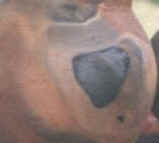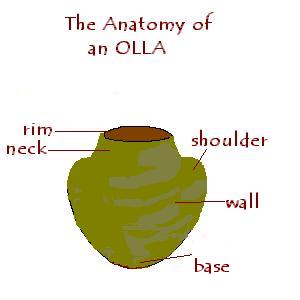American
Pottery
-
American pottery made by the "paddle and anvil" method.
The potter's wheel was unknown in the Americas.
-
How pottery works.
-
The
heat causes clay to become insoluble because of molecular
changes (vitrification). Very durable.
-
No
major kilns found from ancient times.
-
Spanish recorded pit firing.
-
Firing causes color changes through a process
called oxidation reduction. As the ceramic heats, oxygen combines with
iron in clay to form (reddish brown) iron oxide on the surface of the
clay. As the oxygen is burned by the fire and disappears the surface
carbonizes, turning black, gray, or dark brown.
-
slab
molding with coils, paddle and anvil.
-
Burnishing instead of glazing.
-
Temper added to reduce shrinkage.
-
Vegetable resin added to provide sheen.
-
Clay
is responsive to culture change.
- How to make an
olla - the division of labor
A. Preparation
1. By an individual or group, male and/or female.
a. get permission to collect clay.
b. collect clay and leave an offering.
c. haul the clay home.
d. dry clay, bone dry.
e. grind clay as finely as baby powder.
f. add finely ground temper.
g. add liquid and hydrate thoroughly.
h. wedge clay.
B. Create the base.
1. Usually done by an individual. Not a group
process.
a. form a slab.
b. mold slab to shape.
c. let dry slightly and unmold.
C. Create the walls.
1. This is done by the individual artist.
a. roll coils and pinch onto base.
b. add coils to desired height.
c. use paddle and anvil to compact and shape walls.
D. Surface treatment.
1. Another member of the family might take on this
task.
a. paint with slip made of finely ground clay and
minerals if desired.
b. burnish the surface before it is bone dry.
e. engrave into the slightly moist clay.
E. Dry slowly until bone dry.
F. Fire employing oxidation reduction techniques to
color surface.
G. Further surface treatment.
1. Coat while hot with pine pitch for lustrous
surface.

